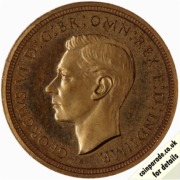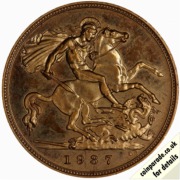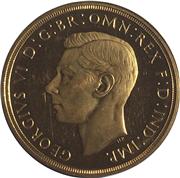 The 1937 Half-Sovereign - George VI
The 1937 Half-Sovereign - George VIThe first (and only) Gold Half-Sovereign of King George VI was only available in Proof. It is much sought after and therefore commands quite a high price. Only 5,001 were minted. SCBC: 4077.
The obverse, by T. Humphrey Paget, shows the bare head of the King facing left. Legend "GEORGIVS VI D: G: BR: OMN: REX F: D: IND: IMP:". Designer's initials (HP) below neck.
 The Reverse, by Benedetto Pistrucci, shows St George and the Dragon. Artist's initials B.P. in exergue.
The Reverse, by Benedetto Pistrucci, shows St George and the Dragon. Artist's initials B.P. in exergue.Image credit: Museums Victoria
Mintage: 5,001 (may include coins in sets)
Minted at The Royal Mint
Below are some coins currently being offered on eBay. As an eBay Partner, We may be compensated if you make a purchase.
In the USA: President is Franklin D. Roosevelt (D-New York). The German airship Hindenburg explodes into flames when mooring to a mast in Lakehurst, New Jersey. Amelia Earhart with navigator Fred Noonan disappear after taking off from New Guinea. New York Yankees defeat New York Giants 4-1, to win their 6th World Series Title. The first feature-length animated cartoon with sound, Walt Disney's Snow White and the Seven Dwarfs opens and is a big hit. Napoleon Hill publishes Think and Grow Rich. The Lincoln Tunnel opens, connecting New York City to New Jersey.
 George VI was King of the United Kingdom and the British Commonwealth from 11 December 1936 until his death on 6 February 1952. He was the last Emperor of India and the first Head of the Commonwealth. His parents were George V and Mary of Teck.
George VI was King of the United Kingdom and the British Commonwealth from 11 December 1936 until his death on 6 February 1952. He was the last Emperor of India and the first Head of the Commonwealth. His parents were George V and Mary of Teck. George did not think he would be King, but took the throne after the abdication of his brother Edward VIII. George VI married Elizabeth (known as the Queen Mother) and the couple were very popular during the war years. George was a heavy smoker and died in 1952 from lung cancer. His wife became knows as "Queen Elizabeth the Queen Mother" and lived until 30th March 2002 when she was 101.
George VI is the father of Queen Elizabeth II.
The Half-Sovereign wa introduced a long time ago, in 1544 during the reign of Henry VII. However it was discontinued in 1604 (along with full sovereigns) and no more were minted until 1817. Production ended again in 1926 (1933 in Australia) and except for a few special issues during the Coronation years, it was 1980 when we saw half-sovereigns again.
As the value is half of one sovereign, that gives the half-sovereign a face value of half a pound or ten shillings - 50p in post-decimal money, although you're going to have to pay somewhat over the gold price if you want to buy one.
The Obverse is the Monarch's head (George VI) and on modern half-sovereigns the Reverse is most often St George and the Dragon (usually the Benedetto Pistrucci version), although other backs have been used.
Specifications for 1937 Half-Sovereign - George VI
- Weight: 3.99 g
- Diameter: 19.30 mm
- Thickness: 0.99 mm
- Purity: 22 carat = 91.67% (11/12ths gold, 1/12th copper. Adding copper makes the coin more scratch and dent resistant)
- Gold Content: 3.6575 g = 0.1176 troy ounce
- Face value: £0.50 = 10 shillings (decimal: 50 pence)
- Monarch: George VI
- These specifications apply to half-sovereigns from 1817.
History
Up until 1604 there was a coin called the English gold sovereign and in 1816 when there was the "Great Recoinage" the name was revived. At that time standard gold (22 carat) was valued at £46 14s 6d per troy pound; this meant a £1 coin needed to weigh 123.2744783 grains or 7.988030269 g. The weight is still the same today.
As a historical note: to maintain the Gold Standard, in 1816 the value of silver was set at 66 shillings for one troy pound and silver coins were only legal for denominations up to £2. The diameter of a half-sovereign is 19.3mm and is only slightly smaller than a full sovereign (22.05mm) so first appearance may confuse inexperienced buyers. You can see in the image on the right, the half-sovereign on the right hand side is quite similar to the full sovereign on the left.
The diameter of a half-sovereign is 19.3mm and is only slightly smaller than a full sovereign (22.05mm) so first appearance may confuse inexperienced buyers. You can see in the image on the right, the half-sovereign on the right hand side is quite similar to the full sovereign on the left.
While you can buy half-sovereigns, many collectors only own them as part of a set.
Formed in the reign of Alfred the Great about the year 886, during the period 1279-1812 it was generally referred to as The Tower Mint as it was housed at the Tower of London. The Master of The Royal Mint has included famous figures such as Sir Isaac Newton.
Since 2010 it has operated as Royal Mint Ltd, a company owned by HM Treasury, under an exclusive contract to supply all coinage for the UK although it also produces medals and coins for other countries. It is currently located at Llantrisant, Wales.
The orignal coinage was Pounds, Shillings and Pence but since decimalisation on 15 February 1971, it is £1 = 100p, that is One Pound = 100 pence. The coinage of the UK is also a long history, the Royal Mint being established as long ago as 886AD when coins were hammered. Today there is perhaps 30 billion coins in circulation, and many (numismatic) collectors coins and sets are issued frequently in gold, silver and other metals.
As an eBay Partner, We may be compensated if you make a purchase.








